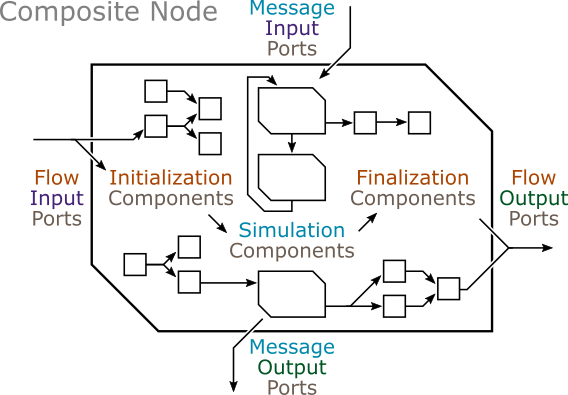| Prev | User Manual – Table of Contents | Next |
Composite Nodes
The composite node integrates other nodes by linking their ports. There are initialization and finalization links, which form a dataflow programming graph. There are also simulation links, which direct messages and support discrete event simulation.

The composite node base class is defined in composite_node.h, which must be included by all composite nodes.
#include <sydevs/systems/composite_node.h>
Sample Declarations
An example of a composite node is the two_stage_queueing_node class found in two_stage_queueing_node.h, which is part of the queueing demonstration project. Below is the class declaration, which inherits from composite_node.
/**
* This node places two queueing nodes end-on-end, so that incoming jobs must
* pass through two queues in order to be processed. The idle duration of this
* composite node is the sum of the idle durations of the two queueing nodes.
*/
class two_stage_queueing_node : public composite_node
{
public:
// Constructor/Destructor:
two_stage_queueing_node(const std::string& node_name, const node_context& external_context);
virtual ~two_stage_queueing_node() = default;
// Ports:
port<flow, input, duration> serv_dt_input; // service duration
port<message, input, int64> job_id_input; // job ID (input)
port<message, output, int64> job_id_output; // job ID (output)
port<flow, output, duration> idle_dt_output; // idle duration
// Components:
queueing_node queue_A; // node representing the 1st stage (queue A)
queueing_node queue_B; // node representing the 2nd stage (queue B)
plus_node<duration> plus; // node adding the idle times of both queues A and B
};
Constructor/Destructor Declarations
Constructors and destructor declarations are the same for all types of nodes (see Atomic Nodes – Constructor/Destructor Declarations).
Ports
Ports are the same as for atomic and collection nodes (see Atomic Nodes – Ports). However, it is important to remember that the ports declared in a composite node refer to the external ports of its external interface, not the ports of its components.
Components
The components of a composite node are themselves nodes of any type, including other composite nodes. The nesting of composite nodes allows models to be developed in a hierarchical fashion. Components are declared in the public section of the composite node to ensure the entire hierarchy is accessible for debugging purposes.
The two_stage_queueing_node in two_stage_queueing_node.h has three components, declared as follows.
queueing_node queue_A; // node representing the 1st stage (queue A)
queueing_node queue_B; // node representing the 2nd stage (queue B)
plus_node<duration> plus; // node adding the idle times of both queues A and B
Note that if two nodes are scheduled to undergo events at the same time, the component declared above the other will have its event occur first. In some cases this may cause the other node’s event not to occur at all.
If a composite node’s components are all function nodes (or composite or collection nodes that contain only function nodes), then for all intents and purposes the composite node will behave like a function node.
Constructor Definitions
The constructor of a composite node initializes both its external ports and its components, and specifies the links that connect all of the ports including the ports of the components.
External ports are initialized with a name and the external_interface() object, similar to atomic nodes (see Atomic Nodes – Constructor Definitions).
Components are initialized with a name and the internal_context() object, which associates them with the internal composition of the node.
There are three types of links. Inward links, defined using the inward_link function, go from one of the composite node’s external input ports to one of its component’s input ports. Inner links, defined using the inner_link function, go from a component output port to a component input port. Outward links, defined using the outward_link function, go from a component output port to one of the composite node’s external output ports.
When connecting two ports via any type of link, the data type associated with both ports must match. Links direct values of the specified data type from the first port to the second.
Below is the constructor definition from two_stage_queueing_node.h.
two_stage_queueing_node::two_stage_queueing_node(const std::string& node_name, const node_context& external_context)
: composite_node(node_name, external_context)
, serv_dt_input("serv_dt_input", external_interface())
, job_id_input("job_id_input", external_interface())
, job_id_output("job_id_output", external_interface())
, idle_dt_output("idle_dt_output", external_interface())
, queue_A("queue_A", internal_context())
, queue_B("queue_B", internal_context())
, plus("plus", internal_context())
{
// Flow Input Links:
inward_link(serv_dt_input, queue_A.serv_dt_input);
inward_link(serv_dt_input, queue_B.serv_dt_input);
// Flow Micro Links:
inner_link(queue_A.idle_dt_output, plus.a_input);
inner_link(queue_B.idle_dt_output, plus.b_input);
// Flow Output Links:
outward_link(plus.c_output, idle_dt_output);
// Message Input Links:
inward_link(job_id_input, queue_A.job_id_input);
// Message Micro Links:
inner_link(queue_A.job_id_output, queue_B.job_id_input);
// Message Output Links:
outward_link(queue_B.job_id_output, job_id_output);
}
Parameter and Statistic Nodes
Parameter and statistic nodes are a special type of function node designed to provide a convenient way to handle parameters and statistics in the context of a composite node. Parameter nodes, which supply values to a simulation, are defined in parameter_node.h. Statistics nodes, which extract values from a simulation, are defined in statistic_node.h. These header files can be included as follows.
#include <sydevs/systems/parameter_node.h>
#include <sydevs/systems/statistic_node.h>
Parameter and statistic nodes are declared as components.
parameter_node<int64> number_of_apples;
parameter_node<duration> service_dt;
statistic_node<float64> percent_growth;
They are initialized in the same manner as other types of components, except that parameter nodes allow a default value to be specified as the third argument.
, number_of_apples("number_of_apples", internal_context())
, service_dt("service_dt", internal_context(), 17500_ms)
, percent_growth("percent_growth", internal_context())
Parameter and statistic nodes have a port of the same name (i.e. parameter or statistic) that can be connected to other nodes via inner links.
inner_link(number_of_apples.parameter, other_node.number_of_apples);
inner_link(service_dt.parameter, other_node.service_dt);
inner_link(other_node.percent_growth, percent_growth.statistic);
| Continue to Collection Nodes |